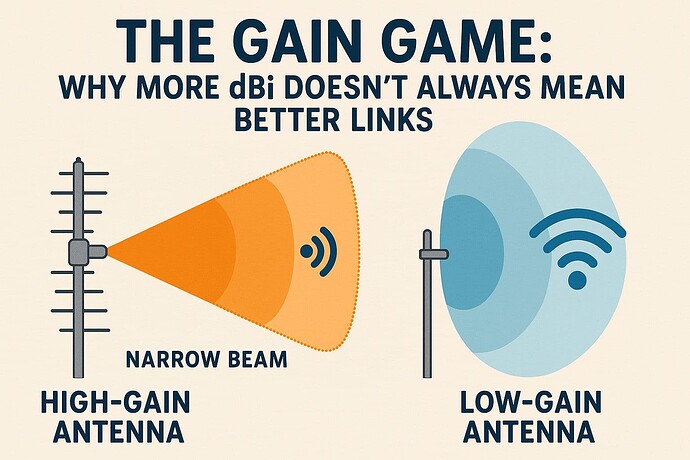You see a spec sheet with 9 dBi vs 3 dBi gain. Instinct says higher is better but in practice, the 3 dBi antenna outperforms the 9 dBi one. Why? Because gain isn’t a guarantee, it’s a tradeoff and when misunderstood, it leads to broken links, blind zones and disappointed engineers.
-
What dBi Tells You and What It Doesn’t?
Gain in dBi tells you how concentrated your radiation is in space relative to an isotropic source. But it doesn’t say where the energy goes, how efficient the antenna is or whether the beam points in a usable direction. Two antennas with identical peak gain may perform drastically differently in terms of coverage, user movement tolerance or signal integrity especially in mobile or multipath-rich environments. -
High Gain Doesn’t Mean High Performance:
A high-gain antenna often narrows its beam to achieve that dBi number. In doing so, it sacrifices angular coverage and becomes highly sensitive to misalignment. This can result in:- Poor performance under motion
- Coverage holes at off-angles
- Low signal strength in NLOS or multipath scenarios
Worse, if efficiency is low or the beam is skewed off-axis, the “high gain” becomes meaningless in practice.
-
Systems Are Messy, Not Ideal:
Your antenna doesn’t live in free space, it lives on a drone, a human body, inside plastic or near ground. That 8 dBi beam might look great in simulation, but in reality:- Device tilt ruins alignment
- Hand grip blocks the main lobe
- Ground planes reflect energy backward
- Structural bends shift the beam
High gain only helps if the system can reliably use the beam. Otherwise, it’s wasted signal in the wrong direction.
-
Critical Formulas:
- Gain:
→ G = D × η - Realized gain (includes mismatch):
→ G_realized = η × D × (1 − |Γ|²) - Effective radiated power (ERP):
→ ERP = P_input × G - Beam solid angle approximation:
→ Ω ≈ (θ_HP × φ_HP) in steradians
→ D ≈ 4π / Ω
- Gain:
-
Real-World Failures from Misleading Gain:
- A 9 dBi patch antenna on a quadcopter loses control when banking as the beam tilts away from the ground station.
- A high-gain Wi-Fi antenna in an apartment provides great signal down the hallway but dead zones in adjacent rooms.
- A smart collar uses a directional BLE antenna, great on a test bench, but when the dog runs, the link cuts in and out due to orientation loss.
- A wearable antenna upgraded to 7 dBi shows worse link margin than a 2.5 dBi one because body proximity detunes and shifts the beam off-target.
High gain isn’t high performance unless it’s in the right direction, under the right conditions and with the right efficiency. Don’t design for dBi, design for reality.
LinkedIn: ![]()
